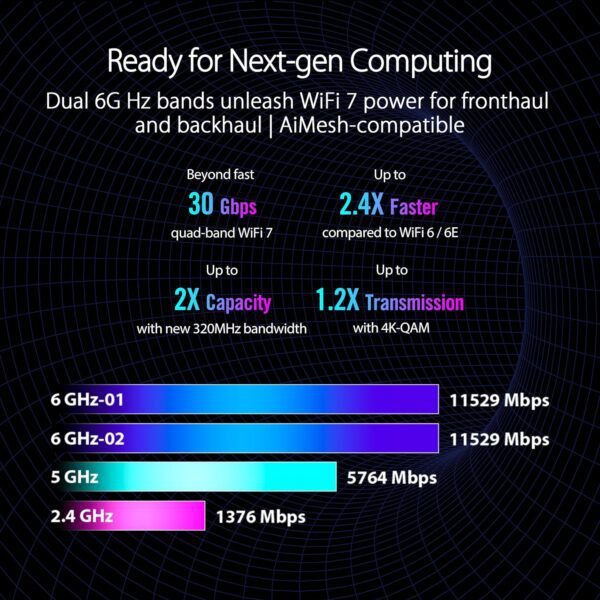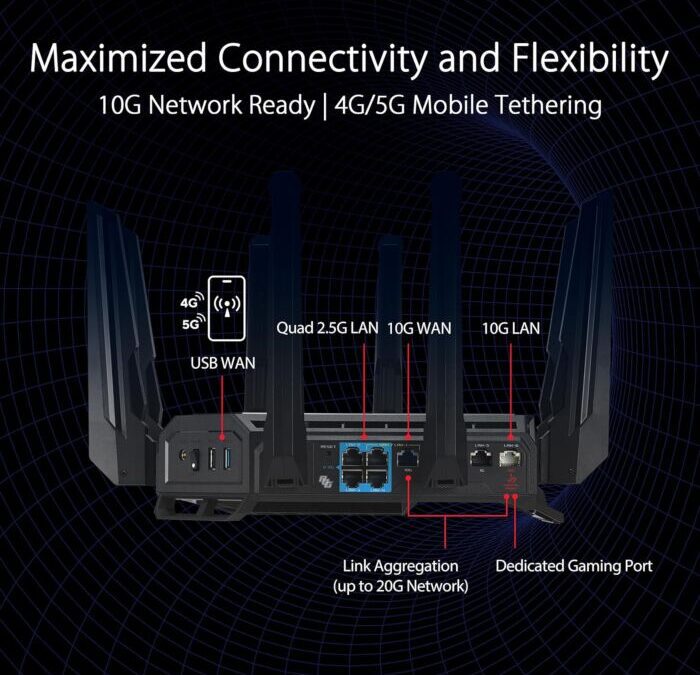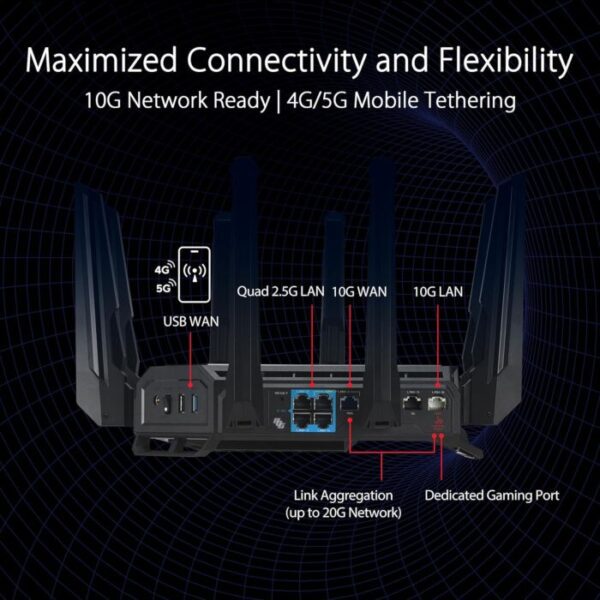Wi-Fi 7’s Game-Changing Key Features & Benefits
Welcome back to our Wi-Fi 7 series, where we explore the new standard in wireless technology and the benefits of WiFi 7 & the 6 GHz band!
In our first post, we covered the basics of Wi-Fi 7 and helped you decide if upgrading now makes sense for your situation with the new 6 GHz band. Today, we’re diving deeper into the specific features that make= this new wi-fi standard special – without all the technical jargon.
The truth is, not all of the latest Wi-Fi 7 features are created equal. Some deliver immediate benefits you’ll notice every day, while others might take time to show their value. Let’s break down they key features of Wi-Fi 7 and which actually matters right now.
What exactly is Wi-Fi 7 and how does it differ from previous Wi-Fi standards?
Wi-Fi 7 (also known as IEEE 802.11be) is the next major leap in wireless connectivity technology. Wi-Fi 7 is also known as IEEE 802.11BE, representing the latest evolution in the Wi-Fi standard family. While Wi-Fi 6/6E made significant improvements over Wi-Fi 5, Wi-Fi 7 brings even more substantial advancements.
Wi-Fi 7 builds upon previous standards with dramatically increased bandwidth, reduced latency, and improved efficiency. Where Wi-Fi 6 was about handling many devices simultaneously, Wi-Fi 7 is set to deliver what many are calling true multi-gigabit WiFi in real-world conditions. Wi-Fi 7 introduces features like 320MHz channels (double that of Wi-Fi 6E), multi-link operation, and 4K QAM modulation, collectively offering a generational leap in wireless performance that Wi-Fi 7 could make wired connections obsolete for many users.
Multi-Link Operation (MLO): The Upgrade to a Wi-Fi 7 Standard Game-Changer
If there’s one feature that makes Wi-Fi 7 truly revolutionary compared to wi-fi standards of the past, it’s that Wifi 7 devices support Multi-Link Operation or MLO, which is supported by the Wi-Fi Alliance. This is entirely new – nothing like it existed in previous WiFi versions.
Advantages of MLO to Wi-Fi 7 Devices
In simple terms, MLO lets your devices use multiple WiFi bands simultaneously. Previous WiFi standards forced your device to connect on just one band at a time (either 2.4GHz, 5GHz, or 6GHz). With MLO, your device can use two or even all three bands at once, enhancing performance with the latest Wi-Fi 7 devices.
How does this help in real life for applications of Wi-Fi 7?
Imagine you’re driving to work and there are three possible routes. With previous Wi-Fi, your device had to pick one route and stick with it, even if it became congested; Wi-Fi 7 allows for better routing options. With WiFi 7 also, MLO can make your data can travel on all three routes simultaneously, or switch instantly when one route gets congested.
The real-world benefits include:
- Rock-solid reliability: If interference hits one band, your connection stays strong on the others
- Much faster speeds: Combine multiple bands, including the 6 GHz band, for higher throughput and dramatic enhanced performance.
- Lower latency: Your router can send time-sensitive data (like video calls) on the fastest path
- Smarter network use: Your router can balance traffic across all available bands
One of our customers recently switched from a WiFi 6 router to our ASUS GT-BE98 Pro WiFi 7. He reported that his video calls, which used to drop several times per day, now remain rock-solid even when his kids start streaming movies in the next room, thanks to Wi-Fi 7’s ability to support multiple high-data devices simultaneously. That’s MLO in action!
320MHz Channels: Unlock the 6 GHz Wi-Fi advantage
WiFi 7 doubles the maximum channel width from WiFi 6’s 160MHz to 320MHz. If that sounds like technical gibberish, think of it this way: WiFi channels are like highways for your data, and WiFi 7 offers a premium experience on these highways. WiFi 6 gave you a 4-lane highway, but WiFi 7 builds upon that and unleashes an 8-lane superhighway.
When does this key feature of Wi-Fi 7 this matter?
This feature delivers major benefits if you:
- Transfer huge files regularly
- You can stream 4K or 8K video seamlessly with the latest Wi-Fi technology.
- Use virtual reality headsets that are compatible with a number of Wi-Fi 7 devices for an enhanced experience.
- Have a gigabit or multi-gigabit internet connection
- Connect multiple buildings wirelessly
For example, one of our small business customers uses a WiFi 7 router with 320MHz channels to wirelessly connect their main office to a workshop 50 feet away. They regularly transfer large CAD files that used to take minutes to send – now they move in seconds.
It’s worth noting that to get the full benefit of 320MHz channels, you need access to the relatively uncrowded 6GHz band, which all our WiFi 7 routers support.
Better Performance in Crowded Places & Businesses
If you live in an apartment building or work in an office with lots of competing WiFi networks, you’ll love this feature. WiFi 7 includes several enhancements that help it perform better in crowded wireless environments:
Enhanced Multi-User Capabilities
Wi-Fi 7 is designed to more devices simultaneously and can more efficiently support them than previous generations of Wi-Fi. This means:
- More stable connections when everyone’s online at once
- Less waiting for your turn to send/receive data
- Better performance during peak usage hours
- Experience a smoother connection with lots of Wi-Fi 7 smart devices in your smart home.
- WiFi 7 is backward compatible with older WiFi Devices (WiFi 5, WiFi 6)
What are the maximum speeds possible with Wi-Fi 7?
The theoretical maximum throughput of Wi-Fi 7 is truly mind-blowing. WiFi 7 increases maximum speeds up to 46 Gbps under ideal conditions, which represents a roughly 5x increase over Wi-Fi 6’s top speed of 9.6 Gbps. In real-world scenarios, you won’t get these maximum rates, but WiFi 7 dramatically improves practical speeds too. Typical home connections could easily sustain 10+ Gbps between devices on the same network.
This is possible because WiFi 7 taps into wider 320MHz channels, more efficient encoding with 4K QAM (Quadrature Amplitude Modulation), and multi-link operation that can use multiple bands simultaneously. Wi-Fi 7 is faster by such a significant margin that it can support multiple 8K video streams, cloud gaming, AR/VR applications, and large file transfers simultaneously without breaking a sweat.
 Advanced Interference Handling
Advanced Interference Handling
WiFi 7 delivers something called “preamble puncturing” (we know, terrible name). In simple terms, it lets your router work around interference instead of fighting through it.
Imagine your wireless spectrum as a busy highway. When previous WiFi versions encountered a traffic jam (interference), they either had to push through it or take a much smaller side road. WiFi 7 can intelligently navigate around specific congestion while still using most of the highway, which is a significant upgrade compared to Wi-Fi 6.
One of our customers in downtown Chicago had terrible WiFi performance due to dozens of competing networks in their building. After upgrading to our Asus BE88U Merlin VPN Enhanced WiFi 7 Router, they reported consistent performance regardless of time of day – something they hadn’t experienced with any previous router.
Deterministic Latency: Consistency You Can Count On
For gamers, remote workers, and smart home enthusiasts, consistent performance can be even more important than raw speed. WiFi 7 introduces new mechanisms that make latency (delay) more predictable and consistent than every previous Wi-Fi protocol.
What does this mean for you?
WiFi 7
- Your online games will have fewer unexpected lag spikes
- Video calls will maintain consistent quality
- Smart home devices will respond more reliably
- Time-sensitive applications will perform better
We’ve had several competitive gamers report that their WiFi 7 routers, like the ASUS ROG Rapture GT-BE30000, have allowed them to play wirelessly with almost the same consistency as a wired connection – something they couldn’t do reliably with previous WiFi versions.
Key Features of Wi-Fi 7 That Don’t Matter Much (Yet)
While WiFi 7 offers other enhancements, some won’t deliver immediate benefits for most users:
Those Sky-High Maximum Speeds
You’ll see WiFi 7 advertised with theoretical maximums of 46 Gbps, which is a significant improvement over previous Wi-Fi generations. That’s impressive, but you won’t see these speeds in real-world use for several reasons:
- Your internet connection is likely much slower than this
- Few applications need this much bandwidth
- You need WiFi 7-compatible devices to get the full speed
- Real-world conditions reduce maximum speeds
Most users will see 2-5× improvements over WiFi 6 – still impressive, but not the theoretical maximum.
AI-Enhanced Capabilities
Some WiFi 7 routers advertise artificial intelligence features for network optimization, which enhance the overall performance compared to Wi-Fi 6. While these features of Wi-Fi 7 sound cool, many require extended learning periods and network-wide implementation before delivering significant value.
What’s Next in Benefits of WiFi 7 Series?
In our next post, we’ll explore the specific advantages of being an early Wi-Fi 7 adopter and explain why getting in now might make more sense than waiting – even with the higher price tag associated with Wi-Fi 7 devices.
Worth An Upgrade to Wi-Fi 7 Router?
If the features we’ve discussed sound like solutions to your networking problems, check out our selection of WiFi 7 routers. Each comes with our enhanced FlashRouters firmware for better security, VPN support, and optimized performance.
Have questions about which features matter most for your specific situation? Our tech experts are always happy to help you find the perfect Wi-Fi 7 router for your needs. Just reach out to our support team for personalized advice on the best Wi-Fi 7 router for your home.
Stay tuned for our next post where we’ll dive into the early adopter advantages of WiFi 7!







